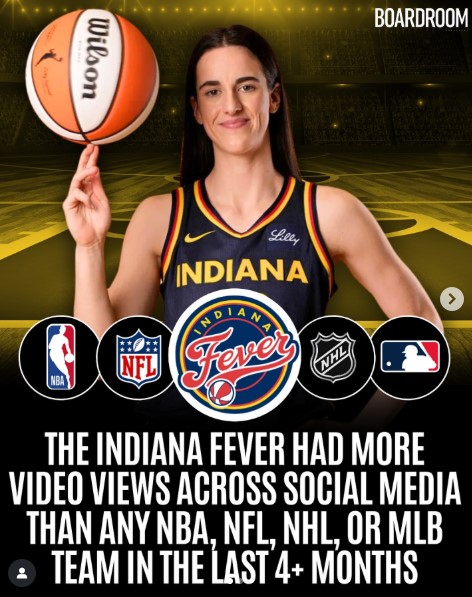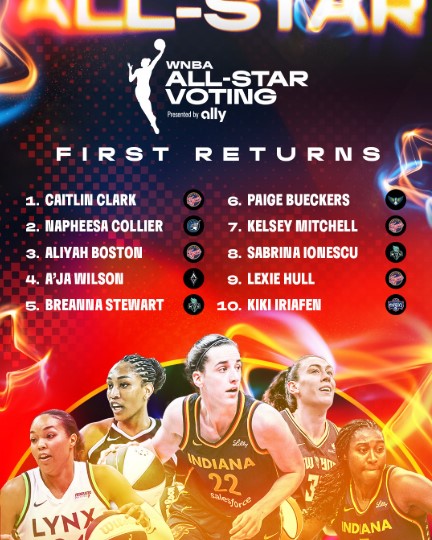The WNBA All-Stars Return: A Voting Revolution Led by Caitlin Clark’s Unprecedented Dominance
The Women’s National Basketball Association has witnessed an extraordinary resurgence in fan engagement and national attention with the return of the WNBA All-Star Game after several years of absence, creating an electrifying atmosphere that has transformed the traditional voting landscape into a battleground of unprecedented proportions. The voting process, which officially commenced with great fanfare and anticipation, has immediately revealed shocking patterns that have left basketball analysts, veteran players, and longtime fans questioning everything they thought they knew about the league’s popularity dynamics and the power of emerging superstars to mobilize massive voting blocs.

At the epicenter of this voting earthquake stands Caitlin Clark, the Indiana Fever rookie sensation who has not merely participated in the All-Star voting process but has absolutely demolished every conceivable record and expectation, establishing a commanding lead that appears mathematically insurmountable and culturally significant beyond traditional basketball metrics. Clark’s dominance in the fan voting represents more than just numerical superiority; it symbolizes a seismic shift in how audiences engage with women’s professional basketball, bringing unprecedented mainstream attention that has elevated the WNBA’s profile to heights previously unimaginable in the league’s twenty-seven-year history.
The astronomical vote totals that Clark has accumulated reflect a perfect storm of factors that have converged to create this remarkable phenomenon, beginning with her legendary collegiate career at the University of Iowa where she shattered numerous scoring records and captivated millions of viewers during March Madness tournaments. Her transition to professional basketball has been seamless in terms of generating excitement, though her on-court adaptation has involved the typical challenges faced by any rookie adjusting to the elevated competition level, yet her ability to draw crowds and generate television ratings has remained consistently extraordinary throughout her debut season.
Clark’s overwhelming lead in All-Star voting can be attributed to several interconnected elements that have created a synergistic effect, including her exceptional shooting range that regularly produces highlight-reel moments from distances that challenge conventional basketball wisdom, her competitive intensity that resonates with fans who appreciate players who demonstrate visible passion and determination, and her marketability that has attracted corporate sponsors and mainstream media coverage typically reserved for established superstars. Furthermore, her social media presence and the organic fan engagement she generates have created a self-reinforcing cycle where increased visibility leads to more votes, which generates more media coverage, which attracts more casual fans to participate in the voting process.
However, the voting battle is far from a predetermined outcome, as several formidable competitors are mounting serious challenges that could potentially disrupt Clark’s seemingly inevitable path to All-Star starter status, with Minnesota Lynx forward Napheesa Collier emerging as the most credible threat to upset the established voting hierarchy. Collier’s candidacy represents the traditional pathway to All-Star recognition, built upon consistent excellence, veteran leadership, and the respect of basketball purists who value fundamental skills, defensive prowess, and the ability to perform at elite levels across multiple seasons rather than relying solely on rookie sensation and media attention.

The possibility of Collier orchestrating a dramatic comeback in the voting process remains mathematically feasible and strategically intriguing, as her supporters argue that her superior overall performance, defensive capabilities, and proven track record of clutch performances in crucial games should outweigh the popularity contest elements that have dominated the early voting returns. Collier’s campaign has gained momentum among basketball traditionalists who emphasize that All-Star selections should primarily reflect on-court contributions rather than social media buzz or television ratings, creating a philosophical divide within the WNBA community about the proper criteria for determining the league’s most deserving representatives.
Perhaps even more fascinating than the individual battle between Clark and Collier is the broader phenomenon of Indiana Fever players achieving unprecedented representation in the All-Star voting process, with multiple team members receiving vote totals that far exceed their statistical contributions or traditional market expectations. This collective surge suggests that Clark’s popularity has created a halo effect that benefits her teammates, as casual fans who initially discovered the WNBA through Clark’s celebrity have subsequently embraced the entire Fever roster, voting for players they might never have known existed without this extraordinary introduction to women’s professional basketball.
The Indiana Fever’s voting dominance raises important questions about the democratic nature of fan voting systems and whether popularity should be the primary determinant of All-Star recognition, particularly when it results in deserving players from smaller markets or less media-friendly teams being overlooked despite superior individual performances. Critics argue that this voting pattern reflects the inherent flaws in any system that prioritizes fan engagement over objective performance metrics, while supporters contend that increased fan interest ultimately benefits the entire league by generating revenue, television viewership, and cultural relevance that elevates all participants.
The current voting dynamics may indeed represent the beginning of a fundamental transformation in how the WNBA operates, markets itself, and connects with audiences, suggesting that we are witnessing not merely a temporary spike in interest but rather the emergence of a new era where individual superstars possess the power to elevate entire franchises and potentially reshape league-wide popularity. Whether this phenomenon proves sustainable beyond Clark’s rookie season, or whether it represents a unique moment that will eventually normalize as the novelty diminishes, remains the most compelling question facing the league’s leadership, broadcast partners, and long-term strategic planning initiatives.
As the All-Star voting period continues toward its conclusion, the basketball world watches with fascination to see whether Collier can mount a successful challenge to Clark’s dominance, whether other deserving players can break through the Indiana Fever’s collective voting surge, and most importantly, whether this unprecedented level of fan engagement represents a permanent shift in the WNBA’s cultural significance or simply an extraordinary moment that will be remembered as the catalyst for women’s professional basketball finally achieving the mainstream recognition it has long deserved.